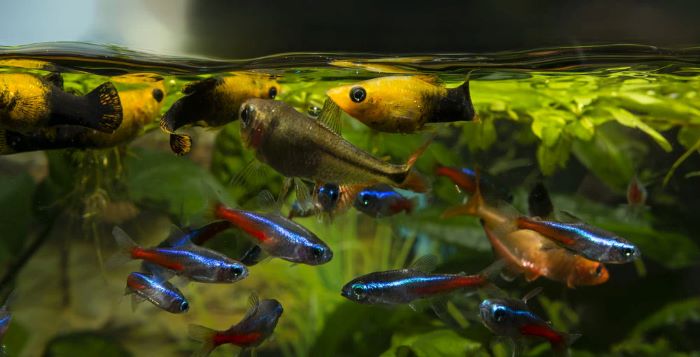Maintaining optimal water quality is crucial for the health and well-being of your aquarium fish. One of the most common tasks for aquarists is performing water changes to keep the tank’s ecosystem balanced. However, an important question often arises: Should I feed my fish after a water change?
Water changes impact various parameters like pH, ammonia levels, and water temperature, all of which can affect fish health. A sudden shift in water conditions can influence how fish behave, including their appetite. Some fish may appear more active or eager to eat, while others may show signs of stress.
In this article, we will address whether it’s safe to feed fish immediately after a water change. We will break down the pros and cons of post-water-change feeding, backed by expert opinions, scientific data, and personal experiences. Additionally, we’ll provide practical tips and best practices for ensuring your fish are fed appropriately while maintaining optimal water quality. We’ll also tackle common mistakes to avoid and answer frequently asked questions, giving you a comprehensive guide to feeding fish post-water change.
Table of Contents
Understanding Water Changes
Water changes are essential for removing toxins like nitrates, excess nutrients, and waste from your fish tank. However, changing the water also means altering various water parameters, which can directly affect your fish’s physiology and behavior.
Water Parameters Affected by Water Changes
- pH levels: pH can shift depending on the quality of the new water being added.
- Ammonia and Nitrite Levels: High levels of ammonia and nitrite are toxic to fish. A water change helps reduce these levels, but an imbalance can lead to shock.
- Temperature: Adding water that is too cold or too warm can shock the fish, affecting their feeding behavior.
Physiological Responses of Fish to Water Changes
Fish are sensitive to changes in their environment. A sudden shift in water temperature or pH can cause stress, suppress their immune systems, and even reduce their appetite temporarily. In some cases, fish may react positively to cleaner water and show increased activity, but this varies by species.
Comparison of Water Metrics Pre- and Post-Change
| Parameter | Pre-Water Change | Post-Water Change |
|---|---|---|
| pH | 6.8 | 7.0 |
| Ammonia (ppm) | 0.5 | 0.2 |
| Nitrite (ppm) | 0.3 | 0.1 |
| Temperature (°C) | 24 | 25 |
This table demonstrates how water quality improves after a change but also highlights the minor fluctuations that can affect fish.
Should You Feed After a Water Change?
Water changes are essential for maintaining a healthy aquarium, but they also raise an important question: Should you feed your fish immediately after a water change? There are mixed opinions on this, and the answer depends on various factors like the species of fish, the size of the water change, and the overall condition of your tank.
Why Some Aquarists Feed Fish After a Water Change
- Cleaner Water Promotes Appetite: After a water change, the water is usually cleaner and free from waste and toxins. This cleaner environment can stimulate fish to become more active and eager to eat.
- Oxygenation Boost: A water change often increases the oxygen levels in the tank, particularly if fresh water is being aerated or filtered more efficiently.
- Species-Specific Needs: Certain species of fish may naturally respond well to feeding after a water change.
Why You Shouldn’t Always Feed After a Water Change
- Fish Stress and Shock: A water change can cause a sudden shift in water parameters. Feeding fish when they’re stressed may result in uneaten food, which can affect the tank’s water quality.
- Digestive Issues: Changes in water temperature or chemistry can impact fish digestion.
- Risk of Water Pollution: If fish are not ready to eat, leftover food will sink and decompose, raising ammonia levels.
Expert Opinions on Feeding After a Water Change
Experts generally recommend monitoring your fish’s behavior after a water change before deciding whether to feed them. Here’s what they suggest:
- Observe Fish Behavior: After completing a water change, spend 30-60 minutes observing your fish.
- Small Feedings: If you choose to feed your fish after a water change, start with a small amount of food.
- Delay Feeding for Sensitive Species: For fish species that are highly sensitive to environmental changes, it’s better to wait several hours or even until the next day before feeding.
How Long Should You Wait to Feed Fish After a Water Change?
The appropriate waiting time varies based on the size of the water change and the sensitivity of your fish. For smaller water changes (10-20%), you can generally feed within an hour if the fish are behaving normally. However, for larger water changes (30% or more), it’s best to wait at least 2-3 hours.
Should You Skip Feeding After a Water Change?
Skipping a feeding after a water change is perfectly fine and often recommended for large water changes. Missing one feeding won’t harm your fish, and it’s a safer option if the water conditions are not yet stable.
Pros of Feeding Fish After a Water Change
- Increased Activity
- Improved Water Quality
- Health Benefits
Cons of Feeding Fish After a Water Change
- Stress and Shock
- Digestive Issues
- Uneaten Food Risks
Best Practices for Feeding Fish Post-Water Change
Wait Times Before Feeding
Experts recommend waiting at least 30 minutes to 1 hour after a water change before feeding your fish. For sensitive species, waiting even longer—up to 2 hours—is ideal.
Monitoring Water Quality
Before feeding, test your tank’s water parameters to ensure everything is stable. Using tools like an aquarium water test kit, check the pH, ammonia, and nitrite levels.
Graph: Water Stabilization Times After a Water Change
Common Mistakes to Avoid When Feeding Fish After a Water Change
- Overfeeding Risks: Overfeeding can cause uneaten food to decay, increasing ammonia levels.
- Impacts on Sensitive Species: Monitor sensitive species carefully and adjust feeding routines accordingly.
Frequently Asked Questions (FAQ) About Feeding Fish After Water Changes
- Can feeding fish right after a water change harm the tank environment? Yes, if the water quality hasn’t stabilized.
- What are the signs that my fish are ready to eat after a water change? Look for normal swimming patterns and appetite.
- Is it okay to skip a feeding after a water change? Yes, skipping a feeding won’t harm your fish.
Conclusion: Key Takeaways for Healthy Fish Feeding Habits Post-Water Change
Maintaining a balanced routine between water changes and feeding is crucial for the health of your aquarium. By following the best practices outlined in this guide, you’ll be able to keep your fish happy, healthy, and well-fed while maintaining optimal water quality in your tank.

Lena Whitmore is the lead writer at FishClans.com, bringing over 10 years of fishkeeping expertise and a master’s degree in Marine Biology to the site. Her extensive knowledge and practical tips have established her as a respected authority in the aquarist community. Lena’s work has appeared in leading publications and she frequently speaks at industry events.
Connect with Lena and FishClans on Facebook, Pinterest, and Instagram.

